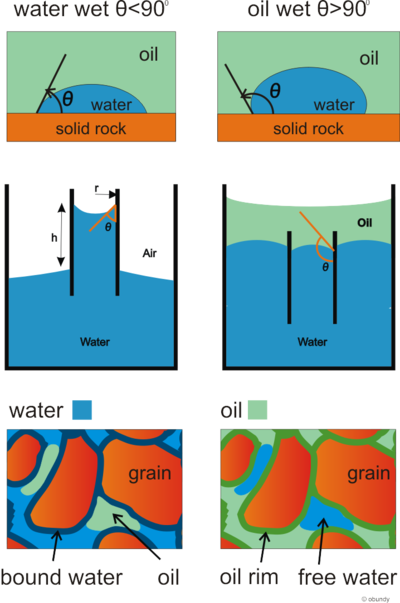Reservoir engineering
| Wiki Write-Off Entry | |
|---|---|

| |
| Student Chapter | University of Brawijaya |
| Competition | June 2015 |
Reservoir rock have many lithologies like sandstones, limestones, granitic, tuff, and shale. Reservoir filled by hydrocarbon on fracture or pores. All reservoir hydrocarbon content connate water . some reservoir content connate water in the micropore that content 10-60% from the pores volume.
Information about scale factor needed to conceptualized reservoir. Scale factor can differences by microscopic; relates to pores and sand grains, macroscopic; relates to conventional core-plug scale, megascopic relates to the scale of grid-blocks in simulation models, and gigascopic relates to regional scale.
Physical Properties of Reservoir[edit]
Homogeneity and Heterogeneity[edit]
Homogeneity factor consist uniform material. Homogeneity factor is similar depositional environment, grain distribution is relatively similar, and similar kind of intensity diagenesa. While the heterogeneity factors is changes in depositional environment, sedimentary material, grain size distribution, and facies, also different type and intensity of diagenesis processes.
Pore Structure and Geometry[edit]
Pore structure varies with the size, shape, and composition of natural grains, as well as fractures. Geometry ranging from <1 micron to 100 micron . Pore characteristic will determine oil recovery method.
Reservoir Pressure[edit]
Fluid in reservoir have hydrostatic pressure that associated reservoir system. Pressure from overburden rock also press the pore and increase the fluid pressure.
Temperature Reservoir[edit]
Temperature at some depth comes from gradient geothermal and it is directly proportional to the depth.
Reservoir Boundary[edit]
Reservoir bounded by impermeable layers and fluid contacts. Field boundaries is ensured through the well but based on well data; electric logs, well flow testing, and repeat formation tester (RFT). Boundary of water and hydrocarbon zones is reduced gradually. This saturation interval resulted in the transition zone. This zone is used as perforation zone in production well.
Physical Properties of Rocks[edit]
Porosity (Phi) 5, permeability (k) mD, fluid saturation (S) %, capiler pressure (Pc) Psi, compressibility (C) Psi-1, resistivity (R) ohm.
Porosity[edit]
Porosity is the amount of free space compared to the bulk volume of rock. Porosity affects the ability of the rock to keep the fluid inside the pores of the rock. The pores can be interconnected and isolated. The pores are interconnected referred to as the effective porosity. Total porosity of rock is a combination of pore volume and pore volume isolated interconnected. While porosity very small called microporosity. Connate water is stored in this microporosity.
- Formula for absolute porosity
- Formula for effective porosity
Permeability[edit]
Permeability is the ability of the rock to drain fluid (hydraulic conductivity) through the pores of the rock. The bigger the pore throat more easily drain the fluid. Unit permeability is miliDarcy.
Absolute permeability (Ka)[edit]
Absolute permeability retrieved from conventional core analysis or by the approach through equations based on log analysis. Empirical equation that can be used is :
- Timur equation:
- Coates equation
Effective permeability (Kef)[edit]
Measurements can be made directly at the reservoir scale well test analysis. Direct measurement is only valid on the condition that a constant fluid saturation. In the analysis of special core analysis laboratory with a known value of relative permeability. Relative permeability equation for Corey Model is:
With effective permeability is
Fluid Saturation (S)[edit]
A fraction of the level of pore space is filled by a fluid.
Capillarity and Wettability[edit]
Capillarity is the power of pressure between the two types of fluid immissicible. Based on capillarity power will be able to determine the level of the fluid content wettability of rock. Wettability is the ability of fluid to wetting the rocks, that the value is represented by contact angel (θ). The cut off limit wettability is θ = 90°. If θ<60°, then the rock are water wet, and if θ>120° the rock has oil/gas wet. Intermediate wet has gotten if the θ around 90° (between 60° and 120°).
Capillary Reservoir Pressure[edit]
Surface pressure of two different types of fluid known as capillary pressure. Capillary pressure is influenced by the pore size and wettability.
With θ wettability contact, σ is surface tension, and r pore size or curvature of the fluid surface. Capillary pressure data known as wetting phase function. Conversion of laboratory data required to determine the reservoir to reservoir capillarity.
If the hydrocarbon pressure equal to the water capillary pressure equal with zero. This point is called as a free water level (FWL).
Changes in capillary pressure against the reference position below the hydrocarbon zone can be seen as a function of:
To determine fluid contacts must be known threshold value of pressure (Pct) is known from the curve Pc against Sw.
Compressibility[edit]
Isothermal compressibility is defined as the relative volume changes due to changes in system pressure at fixed temperature.
Calculate compressibility rock cores in data analysis, it can be used Newman empirical equation:
Compressibility Sandstone:
Compressibility Carbonate:
For hydrocarbon reservoir compressibility can be express by:
Physical Properties of Gas[edit]
Equation of state for gas can be express by
Where P is a pressure in psia, V is volume, mole content is n, R is universal constant with gas is 10.73, and T is temperature in reamur. In a atmosphere condition gas have compressible characteristic than ideal gas. The amount of gas deviations stated in deviation factor z (supercompressibility factor), so :
Specific Gravity[edit]
Specific gravity defined by the rate of gas density in a pressure and temperature sub surface by gas density in equal temperature and pressure (usually in surface). </ref>[1]
Gas Formation Volume Factor[edit]
Formation Volume Factor is ratio between gas volume in reservoir condition by standard condition. For gas volume formation is: [1]
-
- in cuft/scf
-
- in bbl/scf
Compressibility Isothermal Gas[edit]
Compressibility isothermal gas can be calculated by :
Where
is the slope of the line versus P at the point of the review.
Viscosity Gas[edit]
Viscosity gas in P and T identified can be expressed by :
μ1 is the viscosity for 1 atm
Physical Properties of Oil[edit]
Gas Saturation in Oil[edit]
Gas saturation in oil calculated by
Where
Oil Formation Volume Factor[edit]
Formation volume factor is the ratio of the volume of oil in the reservoir (include saturated gas) and the volume of oil on the surface. Oil in reservoir volume VR (include saturated gas) will changes into 2 phase fluid, it is oil stock tank volume VST and gas stock tank volume VGST. Ratio formation volume factor oil Bo expressed by:
Where
- VR = oil volume in reservoir condition
- VST = stock tank oil volume
The unit of Bo is barrel reservoir (rb) per stock tank barrel (STB). For reservoir pressure bigger than bubble point (limit phase changes) pressure (P>Pb), Bo equation is :
For P ≤ Pb, use Standing correlation:
Where
with T in Fahrenheit (°F)
Compressibility Oil[edit]
If there is no PVT analysis data, compressibility oil can be calculated by this equation
For P > Pb:
For P < Pb:
Where T in Fahrenheit (°F)
Formation Volume Factor of two Phase[edit]
Above bubble point pressure, gas and oil combined in one phase. For this case, fluid volume in reservoir have different value in surface volume, and it is called two-phase formation volume factor (Bt), expressed by:
Where,
- Rsi = saturated gas in oil,
- Bg = formation volume factor gas, and
- Rs = gas saturated under bubble point
Oil Viscosity[edit]
Oil reservoir with pressure above the bubble point, the viscosity decreases as a result of a pressure drop. If otherwise (P <Pb), viscosity enlarged in line with declining reservoir pressure as a result of dissolved gas liberated.
For P ≤ Pb:
Dead oil calculated by Egbogah correlation:
Live oil calculated by Beggs-Robinson correlation:
where,
For P > Pb:
Live oil calculated by Vasquez-Beggs Corelation:
Where μob = viscosity live oil in Pb
Physical Properties Water Formation[edit]
Water Formation Volume Factor[edit]
Water formation volume factor (Bw) estimated by McCain correlation:
Where,
Saturated Gas in Water[edit]
The gas can be dissolved in water formation, the factors that influence it is salinity. Estimated solubility is calculated by correlation McCain:
Rswp is saturated gas in pure water:
Where,
Water Compressibility[edit]
Compressibility can be calculated by Osif correlation at pressure above the pressure Pb in water and gas systems.
Where CNaCl is water salinity
Water Viscosity[edit]
Greater reservoir pressure affect the viscosity is getting smaller, the higher the salinity increase water viscosity. The higher temperature causes the viscosity decreases. to determine the viscosity of water McCain correlation can be used.
At atmosphere pressure and reservoir temperature:
where
At reservoir pressure and temperature:
References[edit]
Other Source[edit]
- Koesoemadinata. 1980. Geologi Minyak dan Gas Bumi. Bandung: ITB




![{\displaystyle k_{a}^{1/2}=100\phi ^{2}{\frac {[1-Swi]}{Swi^{2}}}}](https://wikimedia.org/api/rest_v1/media/math/render/svg/620a472fd56c6889f6f5dde82be658a7ff00f103)































![{\displaystyle \log[\log(\mu _{OD}+1)]=1.8653-0.025086(^{\circ }{\text{API}})-0.5644\log {T}}](https://wikimedia.org/api/rest_v1/media/math/render/svg/ea8f9cb91e557a1708556f805aea6bc94ff9fa39)



![{\displaystyle m=2.6P^{1.187}\exp[-11.513-8.98\times 10^{-5}\times P]}](https://wikimedia.org/api/rest_v1/media/math/render/svg/1d795ce21d5002792bd2167cb413ba7017876798)












